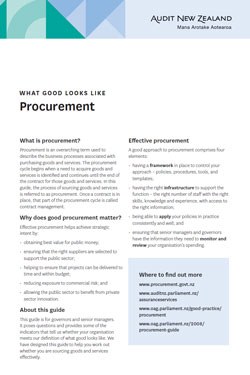What good looks like: Procurement
This is part of our series on What good looks like, produced by our Specialist Audit and Assurance Services team.
What is procurement?
Procurement is an overarching term used to describe the business processes associated with purchasing goods and services. The procurement cycle begins when a need to acquire goods and services is identified and continues until the end of the contract for those goods and services. In this guide, the process of sourcing goods and services is referred to as procurement. Once a contract is in place, that part of the procurement cycle is called contract management.
Why does good procurement matter?
Effective procurement helps achieve strategic intent by:
- obtaining best value for public money;
- ensuring that the right suppliers are selected to support the public sector;
- helping to ensure that projects can be delivered to time and within budget;
- reducing exposure to commercial risk; and
- allowing the public sector to benefit from private sector innovation.
About this guide
This guide is for governors and senior managers. It poses questions and provides some of the indicators that tell us whether your organisation meets our definition of what good looks like. We have designed this guide to help you work out whether you are sourcing goods and services effectively.
Effective procurement
A good approach to procurement comprises four elements:
- having a framework in place to control your approach – policies, procedures, tools, and templates;
- having the right infrastructure to support the function – the right number of staff with the right skills, knowledge and experience, with access to the right information;
- being able to apply your policies in practice consistently and well; and
- ensuring that senior managers and governors have the information they need to monitor and review your organisation’s spending.
Where to find out more
- New Zealand Government Procurement website, www.procurement.govt.nz
- Good practice guides on the Office of the Auditor-General's website, www.oag.parliament.nz/good-practice
| 10 questions | Indicators of what good looks like | |
|---|---|---|
| Framework | 1. Do you have a procurement strategy? |
|
| 2. Is your policy up to date and consistent with good practice? |
|
|
| Infrastructure | 3. Have you got the right number of staff, with the necessary expertise, and in the right structure? |
|
| 4. Do you have information to assist with planning and managing procurement? |
|
|
| Application | 5. Do you plan what you want to achieve, and how you will choose the best supplier? |
|
| 6. Do you always assess and mitigate procurement related risks? |
|
|
| 7. Does your process match the scale, risk, and value of the goods and services being procured? |
|
|
| 8. Are your negotiations well planned? |
|
|
| Monitor and review | 9. Do you review your approach? What have you learnt? |
|
| 10. Are governors informed enough to assess whether procurement is effective? |
|
|
Page created: 4 June 2021

